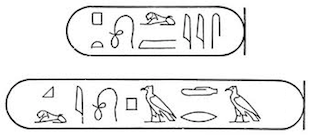The Philae Obelisk by Anoop Sarkar
Introduction
The most famous artifact in the decipherment of Egyptian hieroglyph writing is the Rosetta Stone. However another artifact, called the Philae obelisk (also called the Bankes obelisk) was also instrumental in the decipherment.
The Problem
William John Bankes
acquired this obelisk after it was found at Philae in Upper Egypt
in 1815. He noted two inscriptions on it, one in Egyptian hieroglyphs,
the other in ancient Greek. By comparing the two texts, although
they were not translations of one another, Bankes believed that the
names CLEOPATRA and PTOLMEES (EE can be written as Y and so usually this name is written as Ptolemy in English)
must appear in the hieroglyphic inscriptions.
Both Thomas Young and Jean-François Champollion used this information in their attempts to decipher the script.
We will use inscriptions from the Philae obelisk and compare to inscriptions on the Rosetta stone to find a key to begin to understand Egyptian hieroglyphs.
The Questions
- A cartouche is an oval with a horizontal
line at one end, indicating that the text enclosed is a royal name. Pick which of the following cartouches refers to
CLEOPATRA.

- Find the Greek name written in the Egyptian hieroglyph script as:

Hint: There is a famous city named after him in Egypt where Cleopatra was born, where she ruled and where she eventually died. - Who is the topic of discussion in this inscription from the Rosetta stone?

- Champollion used the Greek translation in the Rosetta stone and his knowledge of Coptic to infer
the sound values for part of the inscription:
?? ankh djet Ptah mer(in Coptic,ankhmeans life;djetmeans for ever; andmermeans love). Use the Egyptian script to write the wordsPtahandmer. Ptah is an Egyptian god. - Write down the translation into English of the Rosetta stone inscription above.